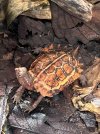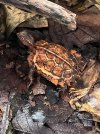Daniel Hortis
New Member
The black breasted leaf turtle (Geoemyda spengler) is know for its small size and good interactivity. However, the high mortality rate of WC specimens and their high maintenance requirements conspire to make these turtles rare in the hobby in many countries. China Mainland, where approximately 1/3 of the natural habitats of these turtles are covered in this place, has a great number of WC spengleri caught from Vietnam, Mainland and Hainan that are available on the market. It is not difficult for a lover to get these guys at a fairly decent price, especially in late spring and summer. However, there are only a few reports from Mainland in terms of long-term keeping or breeding. For one reason, the WC spengleri is very sensitive to sudden changes in the environment and easily to succumb. Aprrt from that, the big dealers (those trading the WC terrestrial turtles) are, for the most part, show zero inclination to neither providing any detail such as the moisture and the annual temperature fluctuation concerning their natural habitats nor instructing them in a proper way so that the turtles could get raised in a healthy way. It is not recommend to get the species overexploited. As the one who has been in the hobby for 2 years and has got into contact with several traders of these turtles, I’d like to share some tips that might be useful in the health and growth of the WC turtles in captivity, just for consideration. Anyway, I would be happy if anyone could give your opinions or supplements to the thread. You suggestions are very important to unravel the mystery of the species lol.
The first is about mindset. That could be operative before a delicious is made to introduce one to your tank. It should be noticed that the spengleri do have a fairly low level of robustness to environmental change. And it is quite common to see things go beyond redemption after certain symptoms have been spotted. It is unsurprised to see threads of those who raise the Kneeled box turtle and the spengleri in the same closure failing to cure the latter from pneumonia while the Chinesebox could successfully recover under proper medication. There are also many reports of severe stress of newly introduced specimens into a group or under bright UVB. Moreover, there are also some reports of seemingly nature-like environment where turtles do not behave in the similar way as if they were in their natural habitats. According to the reports and description of their occurrence I get from the traders and the local who claimed to have seen them in nature. Most of the guys do live in a regions with dim light, moderate temperature and high humidity level. It is recommended to imitate the functional zones more than just catering the setup to the aesthetic something for us.
For the second part, humidity cannot be neglected in the species. According to an experienced hobbyist named ‘twistbutt7’, the spengleri could be spotted in the mountainous regions of Guangxi Province whose humidity varied from 86%-97%, and mating was spotted when humidity hit 97% after raining. And that kinda humidity could get approached in captivity through an enclosed environment with regular humidification. And during humidification, you could see that these guys do have a better interactivity and a stronger desire for food. On the flip side, humidity-related scute cohesion is often reported in the breeders failing to provide them with constantly high-levels of humidity. An ideal level of humidity could be no less than 85%, and it is better if it could be over 90%. Interestingly, when the humidity level goes down significantly, while stuff will occur in their foreheads until humidity level recovers.
The second part is about the diet. Trough few studies has been conducted about their diets in the wild, it components could be extrapolated according to their feces after getting them. After investigating some exclusive merchants in Guangxi Province, I was informed that most of the plugs won’t feed them after caught because that could result in height gastrointestinal-related mortality rate in the transportation. According to several traders, the undigested foliages, fruit stuff and insect stuff indicate an omnivorous diet in the wild. Moreover, a lot of these guys are willing to consume berry and insects in captivity. So it is recommended to feed them with a diversified diet. Furthermore, the addition of chelated calcium powder in their feed in recommended in their diet in that it is beneficial for the growth of their carapace. It is told by several experienced breeders that these turtles has a higher request to the ratio of Ca/P which could be over 2.5. Apart from that, feeding them with calcium-rich food is also highly recommended.
The first is about mindset. That could be operative before a delicious is made to introduce one to your tank. It should be noticed that the spengleri do have a fairly low level of robustness to environmental change. And it is quite common to see things go beyond redemption after certain symptoms have been spotted. It is unsurprised to see threads of those who raise the Kneeled box turtle and the spengleri in the same closure failing to cure the latter from pneumonia while the Chinesebox could successfully recover under proper medication. There are also many reports of severe stress of newly introduced specimens into a group or under bright UVB. Moreover, there are also some reports of seemingly nature-like environment where turtles do not behave in the similar way as if they were in their natural habitats. According to the reports and description of their occurrence I get from the traders and the local who claimed to have seen them in nature. Most of the guys do live in a regions with dim light, moderate temperature and high humidity level. It is recommended to imitate the functional zones more than just catering the setup to the aesthetic something for us.
For the second part, humidity cannot be neglected in the species. According to an experienced hobbyist named ‘twistbutt7’, the spengleri could be spotted in the mountainous regions of Guangxi Province whose humidity varied from 86%-97%, and mating was spotted when humidity hit 97% after raining. And that kinda humidity could get approached in captivity through an enclosed environment with regular humidification. And during humidification, you could see that these guys do have a better interactivity and a stronger desire for food. On the flip side, humidity-related scute cohesion is often reported in the breeders failing to provide them with constantly high-levels of humidity. An ideal level of humidity could be no less than 85%, and it is better if it could be over 90%. Interestingly, when the humidity level goes down significantly, while stuff will occur in their foreheads until humidity level recovers.
The second part is about the diet. Trough few studies has been conducted about their diets in the wild, it components could be extrapolated according to their feces after getting them. After investigating some exclusive merchants in Guangxi Province, I was informed that most of the plugs won’t feed them after caught because that could result in height gastrointestinal-related mortality rate in the transportation. According to several traders, the undigested foliages, fruit stuff and insect stuff indicate an omnivorous diet in the wild. Moreover, a lot of these guys are willing to consume berry and insects in captivity. So it is recommended to feed them with a diversified diet. Furthermore, the addition of chelated calcium powder in their feed in recommended in their diet in that it is beneficial for the growth of their carapace. It is told by several experienced breeders that these turtles has a higher request to the ratio of Ca/P which could be over 2.5. Apart from that, feeding them with calcium-rich food is also highly recommended.


